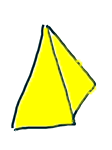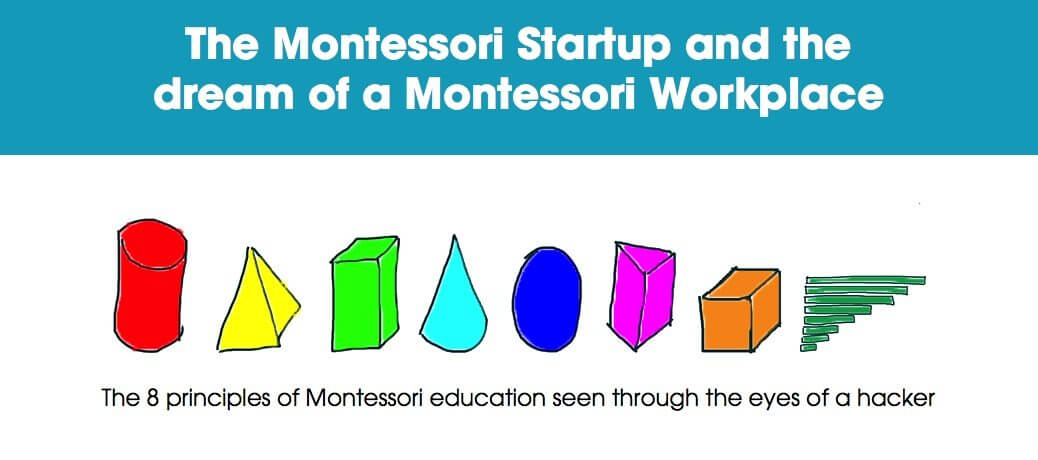
The idea that Montessori can be applied to the workplace has been floated last September by The Economist newspaper as a negative effect of Silicon Valley’s cultural predominance. I beg to differ and thus I invite you first to better understand how much the Montessori culture resembles the hacker culture.
So let’s explore the 8 principles of Montessori education with the eyes of a hacker.
What is Montessori
Montessori is an educational approach invented by the Italian physician and educator Maria Montessori that sees children as motivated doers, classrooms as highly organized spaces, play activities as learning opportunities, where children can learn at they own pace and where teachers act as facilitators rather than conductors.
It all started to happen at the beginning of 1900 in Rome’s S. Lorenzo neighborhood. Now Montessori is a widely adopted system for kindergarten and elementary school.
If your interest should go deeper, it might interest you to know that my source for this article is the book Montessori: The Science Behind the Genius. (Disclosure: the link is affiliated)
The 8 principles of Montessori Education
Angeline Lillard lists 8 principles to describe the Montessori approach. I have tried to summarize them below and see where the hacker, the startup and the workplace fit in them.
1. Movement and cognition are closely entwined and movement can enhance thinking and learning.

If the 1910 insight was that movement and knowledge are connected, today we know that sitting still is also killing us. Standing desks are spreading fast and treadmill desks are starting to see a market. Standing meetings are routine in startups, walking and running conversations are more rare in the traditional workspace, but catching on.
Knowledge workers understand the value of enhancing our health, productivity and well being by moving while we work.
2. Learning and well-being are improved when people have a sense of control over their lives.

– ANGELINE LILLARD
Montessori underlines the importance of concentration, that she described as a psychological state involving “focused attention, increased cognitive functioning, persistence & effective involvement”.
Her system fosters concentration over longer periods of time, allowing for longer uninterrupted cycles to be dedicated for difficult tasks and to achieve a deeper concentration akin to what Mihaly Csikszentmihalyi would describe 80 years later as the state of “Flow”.
Control is achieved in the Montessori classroom by giving the kids direct access to the materials that are positioned on shelves at their own height, clearly organized for productivity.
But it does not end here. Children are also empowered by the fact that they can learn directly from the materials, learning in a state of independence and solitude and avoiding if possible whole-class group forming activities that would assume that all students are at the same level. It’s not that Montessori dislikes groups, but she fosters mainly spontaneous group building by affinity.
Startups and large companies should replicate this model as it is: first and foremost allow their employees self organized time in order to reach a state of creative flow. Secondly by allowing the spontaneous formation of groups around common goals and motives.
Some companies are already on the right track: 37signals, an innovative software firm, for instance makes sure their employees are guaranteed independently organized, interruption-free time in order to reach their objectives.
3. People learn better when they are interested in what they are learning

Nerds do stuff that they love, lots of it. Often you can see geeks bring their work home, dwell on a problem, learn new stuff in their free time. Passionate programmers will tell you that they feel privileged that people pay them for an activity that is already so satisfying for them.
In a startup if you don’t have a great passion towards what you’re tackling, you will fail. And even a lot of passion is not enough to succeed. That passion is just what drives you to begin facing the challenge.
To bring interest to the workplace we need to recognize that each person inside our organization has a different drive, a distinct motivation and set of interests, that there is no cog equal to another: organizations can learn a lot from how open source projects are able to succeed outside of common organizational boundaries or even how some companies are able to bring productivity without hierarchy, by empowering the individuals and letting them share the responsibility of the well-being of the company.
4. Tying extrinsic rewards to an activity, like money for reading or high grades for tests negatively impacts motivation to engage in that activity when the reward is withdrawn.

Geeks don’t choose startup jobs just for the money, they need to pay the bills and may have expensive hobbies. But for them the reward is in making something, in the act of creation, of innovation.
Making work more challenging thus more enjoyable for everyone in all environments is the objective of healthy organizations.
5. Collaborative arrangements can be very conducive to learning.

Startups are often founded by friends. Networks of freelancers are often also composed of friends, that work and hang out together. Spontaneous networks of friends develop in all sorts of organizations.
Startup mentorship programs do all they can to mix together experiences of older entrepreneurs with young founders. Outside the education system it becomes easier to mix with different ages again. But learning from our older peers is still not a habit everywhere.
The workplace would change for the better if we suddenly took notice that friends work better together and that we need to mix people with different interests and skill levels to create the conditions for sharing knowledge.
6. Learning situated in meaningful contexts is often deeper and richer than learning in abstract contexts.

“Education, as today conceived, is something separated both from biological and social life. All who enter the education world tend to be cut off from society… People are prepared for life by exclusion from it.”
– MARIA MONTESSORI
The kind of learning that happens in computer programming, in startups and everywhere innovation is at work is often deeply rooted in context.
Programming languages and environments often provide sufficient context in themselves to motivate developers. Sometimes the challenge comes from the market and is undertaken by founding teams in startups. Sometimes the motivation comes from the aims of Open Source projects. Sometimes the context is the lab and the motivator is just innovation.
Hackers know how to create meaning. This is one of the reasons they get things done.
7. Particular forms of interaction are associated with more optimal outcomes.

Put in other way, they simply stay out of the way and let the kids to their work.
And it is how entrepreneurs, startup founders and managers at all levels should behave with their staff.
8. Order in the environment is beneficial to people.

Our offices are often spaces that are not organized for well-being. A Montessori approach to workplace architecture would be beneficial to create spaces where people can be truly productive. Better organized, more practical and wellness-oriented spaces are only the beginning.
Inflexible office schedules, matched with slow email systems & clumsy corporate apps are the norm in the modern workplace: our productivity tools are often not up to the task. We should make sure that every aspect of the work environment is thought about and works in the direction of making us productive and, possibly, creative.
My Montessori coming out
I also went to a Montessori kindergarten as a kid. And I loved it. The sense of control, of being allowed and encouraged to naturally behave as an introvert, the “private” relationship with the teachers, the “hands on” approach: these are the elements that I have most appreciated from Montessori education. And this is also what is sorely missing in most formal education. I would go so far as to assume that the lack of Montessorian elements in high school and college are probably the reason I belong to the cliché of the geeky-college-dropout-entrepreneur.
From Montessori to programming
My path out of Montessori and into traditional education was dampened at age 6 by a lucky encounter: an IBM AT/XT Personal Computer. My approach to the computer, starting with studying DOS and BASIC, was quintessentially Montessorian. But now it dawns on me: all tinkering, hacking and making is Montessorian in a way. Why? Trying, testing, experimenting, working on feedback loops, progressing on your own at your own pace, working alone, finding oneself immersed in an environment rich with stimuli, learning how to learn, learning general methods and languages, working in an environment that has been organized for productivity: all those are traits that connect Montessori with the hacker approach.
Giving names and definitions to those traits can be instrumental also for non-geeks to better understand how and why geeks in the workplace behave differently and start to open the doors of this club to non technical people.
The Montessori Startup and the path towards a Montessori workplace
With this exploration of Montessori theory and after reviving my memories of my childhood, I have developed even more respect for this method and I am convinced that – if for the sole purpose of education – the Montessori approach is here to stay. But there is more.
I feel that we have a lot to learn from the respect of the introverted nature of knowledge work that Montessori expresses, the appreciation for productivity by design, the sparing but conscious use of group-work, the process of individual empowerment that her methods foster.
I want to go further and say that startups are naturally predisposed to be Montessorian, as they put you head first, hands on, in the middle of the substance you need to analyze, in the midst of the code you need to crack.
We could be easily on the path to a Montessori Startup. Hackers already manage themselves in a Montessorian way. They have a natural tendency to handle their own time, attention and context in a Montessori way. If the whole organization gets informed by those same principles it can be easy to realize the dream of a fully Montessorian company.
The path is not so easy for bigger organizations. More conscious managers – that indicate goals and then stand out of the way, that provide great tools for productivity and meaningful contexts for employee development – are needed to start implementing the Montessori workplace.
This is only the beginning of a bigger exploration. If you think we should start working towards a Montessori workplace then let’s debate the how and the when in the comments.
If you liked this post…
If you liked the themes and the spirit of this post I suggest you also check out Montessori Startup: what would a Montessori workplace look like.
One last thing, please subscribe to my almost monthly newsletter where I tackle marketing, entertainment, entrepreneurship, innovation and productivity.

